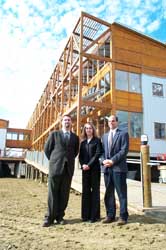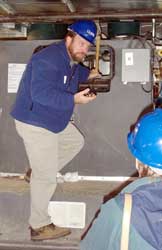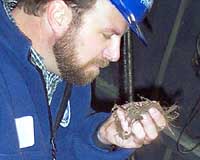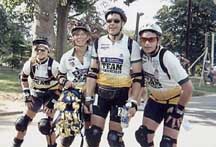 Chesapeake Bay Foundation: Chesapeake Bay Foundation:
New Digs Tread Lightly on the Land
photos by Mark Burns
Architect Greg Mella, mechanical engineer Cindy Cogil and electrical engineer Brian Charles with the eco-friendly building they helped design for Chesapeake Bay Foundation’s new headquarters.
"I am itching to do another one of these," says Greg Mella, project architect for Chesapeake Bay Foundation's new headquarters. "It's changed the way I look at buildings."
Mella stands before the Philip Merrill Environmental Center, the now-concrete brainchild of a unique ensemble effort of architects, engineers and Chesapeake Bay Foundation's own ecological thinking. Nearly complete, the center rises from a peninsular plot at the confluence of Black Walnut Creek and Chesapeake Bay, with views of Thomas Point Lighthouse and the Bay Bridge. Flanking the facility are wetland meadows and a patch of forest; out front is a swath of open, sandy beach.
The building itself, at 32,000 square feet, is an open and airy rectangular spread of wood, glass and corrugated steel siding perched on a concrete and stilt foundation. Its front, facing south toward the Bay, is a facade of windows fronted by exposed structural beams and columns. It's already being hailed as the nation's most ambitious model of eco-friendly design to date.
"A lot of the things we did for this were done for the first time," says architect Mella, who had never worked on a large-scale green building project before this. "It was definitely a learning curve."
Environmentally friendly innovations include a climate control system that shuts off the air and opens mechanical windows automatically when the weather's nice. There's also a lighting system that dims or brightens in reaction to ambient light.
Other touches are flushless composting toilets, which collect deposits in basement storage tanks and keep the piles aerated to cut the smell and break the spoil down into rich compost. The privies have become unlikely media darlings, with cameras crowding bathrooms for a peek. But it's nothing new. "Chesapeake Bay Foundation has had flushless toilets for 20 years," says facilities manager Chuck Foster, who speaks matter-of-factly about the chore - easy to say, it's not his job - of "fluffing" the potty pile with a clam rake each week.
Flushless toilets at the new office building drop two stories into holding tanks, where — as facilities manager Chuck Foster demonstrates — the waste becomes odorless compost.
Still more environmental empathy is found in the materials. Wood is either recycled or taken from sustainable young-growth forests. Parallel-strand lumber, which uses strips of wood glued together rather than the heart of old-growth timber, makes up all the beams and columns. Siding is recycled steel. Recycled wood fiber panels appear as window trim and cabinets. Wood flooring is bamboo. Cork tiles imported from Portugal replace chemical-laden, germ-catching office carpet. Interior walls are finished in unpainted particle board. Pegboard, the kind found in so many workshops, works for interior trim. Paint is sparingly used to avoid fumes. To cut transportation-related pollution, 51 percent of the materials used were found within 300 miles of the site - such as wood from old pickle barrels found on the Eastern Shore.
All these elements assemble into an open floor plan, arranged so that sunlight harvested by the vast windows can reach everyone and cut dependence on electric lights. Extending the center's energy efficiency are occupancy sensors that automatically shut off lights and computers when nobody is around. Solar panels and a geothermal heating and cooling system supplement traditional climate controls. Alternative sources will supply 34 percent of the center's energy needs.
As with energy, water is conserved. Some salvaged pickle barrels serve as cisterns, feeding water to showers and hand-washing sinks. Landscaping uses only native plants, thus cutting out water for irrigation. The meadow will be planted with native, drought-resistant summer grasses and wildflowers. And, of course, there are no flushing toilets. The Foundation expects the center will use 90 percent less water than comparable office buildings.
Transit, too, is earth friendly. The foundation will keep a hybrid gas-electric vehicle on hand, with fueling station, for its workers to use. Workers who walk, cycle or kayak to the job will find showers on site. The parking lot is laid in chipstone to avoid runoff.
"If we didn't do it, how could we ask other people to do it?" asks Chesapeake Bay Foundation president Will Baker. The success of this project, he hopes, will inspire similarly sensitive efforts elsewhere in the Bay's watershed. It's already won Philip Merrill Environmental Center the only platinum rating from the U.S. Green Building Council's Leadership in Energy and Environmental Design rating system.
The entire project - which includes the cost of land and sale of conservation easements to protect the land against development - cost the Foundation a total of $11.6 million, raised in a special campaign. It cost no more, the Foundation says, than an institutional project of similar scope that would shell out cash for marble lobby floors and other niceties.
This was also a victory for open space. The Annapolis peninsula's Bay Ridge community approached the Chesapeake Bay Foundation after developers started eyeing the site of the old Bay Ridge Inn for as many as 60 houses. The Foundation was looking for a new headquarters, and after seeing the site they got snagged on the lure. At first, they hoped to restore the old inn, but structural engineers deemed it beyond repair. Thus the inn was deconstructed, much of it salvaged for reuse in the new building. The Philip Merrill center rose from the inn's footprint.
With the land in hand, Chesapeake Bay Foundation now has a microcosm of the entire Bay ecosystem - except upland bogs - right in its own backyard. Plans are in the works to restore non-tidal wetlands, to bring native grasses and wildflowers into the meadow, to restore an understory and canopy to the former wooded picnic area, to plant sub-aquatic grasses and to raise oyster gardens.
"We want to have examples of as many Bay habitats as possible," says restoration director Bill Street. The next phase of construction at the site calls for a restoration center, where the Foundation will raise sub-aquatic vegetation, oysters and native plants.
But that's for later. Coming sooner is the first weekend in December, when Chesapeake Bay Foundation's crew starts moving into their new, idyllic surroundings. Facilities manager Foster anticipates a few snags, conceding that they probably haven't solved every problem.
The center will then be open for public tours.
Though staff must hope that calls of nature will no longer be disrupted by the curious peering into the flushless toilet stalls.
 Where Do the Palms of Summer Go? Where Do the Palms of Summer Go?
All summer long, palm trees make Chesapeake Country seem the northern reach of the tropics. Until the frost, when the truth outs. Then tropical foliage, pleasingly placed by business owners, must come indoors or face impending death.
Vera Freeman of Vera's White Sands on St. Leonard's Creek, in Lusby, claims credit for bringing the tropics to Chesapeake Country. "Now you'll find many places have banana trees around here," she says, "but mine are the original ones from 35 years ago." When she closes for the season in September, her trees come indoors, wintering in their own glassed room that faces southeast. The banana trees are able to live through our northern winters indoors with their tops trimmed and roots stuck in five-gallon buckets. If maintained in a 50-degree environment, the trees will sprout new shoots and swell the imported tropics next summer.
At Rose Haven, Herrington Harbour has transformed itself into the resort marina each year for 20 years with a jungle of tropical foliage. Coconut, queen and date nut palm trees, banana trees and flowering plants mingle to create a mirage of paradise. Imported directly from the Sunshine State, all the palms but the bananas are shipped up each year at the cost of a heavy price tag and a long tractor trailer ride.
The amount of money spent on the tropicalizing is "incomprehensible," says Jim Carroll, grounds and maintenance supervisor at Herrington Harbour. Banana trees, costing a few hundred dollars each, have not had to be replaced in the past 20 years. For now, everything else dies. Winterizing some of the buildings at Herrington Harbour will eventually provide a safe haven for the tropical transplants.
Calypso Bay Restaurant and Dock Bar at Tracy's Landing brings the tropics to its outside dining area and tiki bar with coconut palms as well, scattering them through the white sand. The need for tall ceilings and warm temperatures dooms these tropic giants. There was hope the fronds would be recycled when a local school asked to hand pick them for the set of a festival with a South Pacific theme. With November here, they had better hurry.
Heart to Table: Sharing Thanks
 Table for two? Not in this case. Table for two? Not in this case.
The outpouring of generosity from the Chesapeake community requires a large table this year. It's a table you can sit down to - or one you can serve. From heart to table, here is Chesapeake Country's shared Thanksgiving menu.
Join Larry Griffin and We Care & Friends along with thousands of friends at the Stanton Center in Annapolis at 4pm on Monday, November 20, for Thanksgiving dinner. Serving over 4,000 people last year, Griffin is pleased that so far this year's guests number only about 3,500 - only in hopes that many have gotten back on their feet and rejoined their families. About 150 volunteers will help serve a traditional holiday meal, donated by some five dozen local restaurants and businesses, including Surfside 7, Eastport Clipper and McNasby's Seafood. Local musicians entertain.
Griffin and Mike Flanagan, vice president of the nine-year-old charity, hope to provide more than physical nutrition for those in need. "Our vision is to open a cultural healing center where we could provide a safe environment for those who need it," says Griffin. Share the day with We Care & Friends or help contribute to the vision. Volunteers still needed. Information? Larry Griffin: 410/269-0578.
The Salvation Army in Annapolis gathered names and addresses of 200 families who applied for assistance this holiday season. Those families will pick up food donations from the Naval Academy and food certificates on November 21 at 351 Hilltop Lane. The food pantry is open every Monday to Friday 8am to 12:30pm and 1 to 4pm and is always in need of donations. Information? Paul Egan: 410/263-4091.
Goodwill Inc. provides not only good food but also entrée to a good job. Goodwill Industries of the Chesapeake will hold its 11th Annual Thanksgiving dinner in Annapolis on Wednesday, November 22 from noon to 3pm at Asbury United Methodist Church at 87 West Street. Local volunteers will serve nearly 300 children and adults a full turkey dinner with all the trimmings. Guests will be able to create resumes, learn interviewing skills and do job searches with the assistance of career development staff. Information? Cindy Piazza: 410/837-1800.
·he Christian Assistance Program - a network of churches in Odenton, Severn and Gambrills - gathers names from social services and delivers each year baskets brimming with all the trimmings for a wonderful holiday meal. Food and clothing is provided year round for over 5,000 people in the community. Donations are always welcome. Information? 410/551-9238.
·Twenty baskets will be distributed to local families on November 19 by Grace Evangelical Presbyterian Church in Mayo, with the help of food and cash donations at Sunday services. Information? 410/266-8360.
·Cedar Grove United Methodist Church in Deale delivers 25 families with turkey and fixings for a "well-balanced, bountiful Thanksgiving meal" thanks to cash donations from church members. Information? Church office: 410/867-7417.
In Solomons, the Lighthouse Inn Restaurant serves their 10th Annual Thanksgiving meal on November 23 from noon to 3:30pm. "No questions asked. Everyone is welcome. The more the merrier," says event coordinator Jennifer Jordan. She expects to serve about 500 people, including delivered dinners for guests who cannot get to the festivities on their own. To place an order or request transportation call Jordan weekdays 8am to 4pm: 410/326-2444.
While most are enjoying a nourishing holiday meal, some will skip right to dessert. Navy active duty personnel get fresh-baked pies by special delivery at their barracks or the watch post. Sponsored by the Naval Academy Chief Petty Officers Association, the pies are donated and delivered by naval families and citizens. Information? Family Service Center: 410/293-2641
Again, this Thanksgiving, Chesapeake Country serves straight from the heart.
Update: Indefatigable Rollerblader Endures Success
Tina Gouin, left, and teammates from the Leukemia and Lymphoma Society’s Team in Training, D.C. chapter.
On October 1, Tina Gouin was rolling through the scenes of this story. Literally. Enduring the bumps and potholes in the 86-mile in-line skate from Athens to Atlanta, Georgia, benefiting the Leukemia and Lymphoma Society Tina recalls the event with simultaneous relief and joy. "All the blisters have healed, my chiropractor has straightened me out twice an d my legs seem to be recovered," she reports. d my legs seem to be recovered," she reports.
Tina skated with the Leukemia and Lymphoma Society's Team in Training, D.C. chapter, which boasted the largest percentage of skaters in the fund-raiser, sending 50 ranging in age from 23 to 51. Almost 800 skaters registered for the annual event, raising $500,000 for the cause. "Thanks to the support crews, my friends and my sponsors, I raised over $3,300," Gouin says.
Gravity did not take hold of Gouin's group until mile 24. Until then they were "literally flying," finishing the first 15 miles in under an hour. But speedy downhill and uneven terrain led to a dangerous crash. "You never want to hear the sound of plastic grinding across asphalt and soft objects pounding the ground," says Gouin. "It was awful." Four of her team members had "rashed," and at the 38-mile mark one of the injured members had to bow out.
Nature soon took its course. The hills started to get bigger. But neither nature nor physical exhaustion could stop her wheels from turning. A wristband naming the people affected by leukemia/lymphoma fueled Gouin's drive. With each glance, she remembered that, "this pain I was in was but a drop in the bucket to what they had gone through. My resolve hardened and my second wind came rushing on."
Hands clasped with six teammates, Gouin finished in eight hours and 43 minutes. What she felt was "utter relief followed by searing pain as my boots were pulled off taking socks and blistered skin with them." says Tina.
Way Downstream ...
In Pennsylvania, voters in 14 municipalities showed in the election how much they value open lands: They voted to raise their taxes and issue bonds from keeping fields and farmland from turning into subdivisions and shopping centers. Nationally, over half of 55 states had such ballot questions passed, according to State Resource Strategies. Last election, fewer than one-third passed ...
In Massachusetts, Rep. Barney Frank had this to say about Ralph Nader's Green Party and its devastating effect on Al Gore's re-election hopes: "A political movement based on hatred of McDonald's is fundamentally flawed" ...
In Sebastopol, Calif., pop. 9,000, the Green Party had the last laugh. For just the second time in American history, the Green Party took control of a city council. Said one of the Green Party victors, Sam Spooner: "The voters have made a clear choice for a future based on ecological values and a livable community for everyone" ...
Our Creature Feature comes from Saline, Mich., where a golden retriever puppy named Benjamin is following in the pawprints of his father, Charlie, working the pumps at Harry's Service Station.
Benjamin, like Charlie, takes money from customers and delivers it to the register. Since Charlie died in August, Benjamin has been in training. But station owner Rick Parsons observed that he hasn't quite mastered the job: "He's eaten $68."
Copyright 2000
Bay Weekly
|